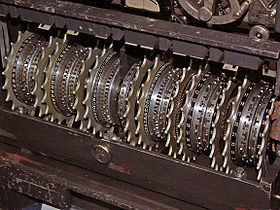
Pinwheel (cryptography)
Encyclopedia

Cryptography
Cryptography is the practice and study of techniques for secure communication in the presence of third parties...
, a pinwheel was a device for producing a short pseudorandom sequence of bit
Bit
A bit is the basic unit of information in computing and telecommunications; it is the amount of information stored by a digital device or other physical system that exists in one of two possible distinct states...
s (determined by the machine's initial settings), as a component in a cipher machine. A pinwheel consisted of a rotating wheel with a certain number of positions on its periphery. Each position had a "pin" or "lug" which could be either "set" or "unset". As the wheel rotated, each of these pins would in turn affect other parts of the machine, producing a series of "on" or "off" pulses which would repeat after one full rotation of the wheel. If the machine contained more than one wheel, usually their periods would be relatively prime to maximize the combined period.
Pinwheels might be turned through a purely mechanical action (as in the M-209
M-209
In cryptography, the M-209, designated CSP-1500 by the Navy is a portable, mechanical cipher machine used by the US military primarily in World War II, though it remained in active use through the Korean War...
) or electromechanically (as in the Lorenz SZ 40/42). Other cipher machines which used pinwheels include the C-52
C-52 (cipher machine)
The C-52 and CX-52 were cipher machines manufactured by Crypto AG starting 1951/1952. These pin-and-lug type cipher machines were advanced successors of the C-38/M-209. The machine measures 8 1/2in × 5 3/8in × 4 3/8in...
, the CD-57
CD-57
The CD-57 was a portable, mechanical cipher machine manufactured by Crypto AG, first produced in 1957.The CD-57 was a portable, mechanical cipher machine manufactured by Crypto AG, first produced in 1957....
and the Siemens and Halske T52
Siemens and Halske T52
The Siemens and Halske T52, also known as the Geheimfernschreiber , or Schlüsselfernschreibmaschine , was a World War II German teleprinter cipher machine...
.
Pinwheels can be viewed as a predecessor to the electronic linear feedback shift register
Linear feedback shift register
A linear feedback shift register is a shift register whose input bit is a linear function of its previous state.The most commonly used linear function of single bits is XOR...
(LFSR), used in later cryptosystems.

